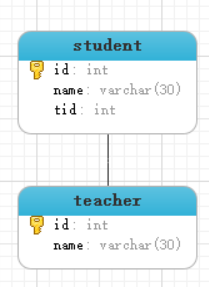mybatis-一对多查询
准备阶段(一个老师对应多个学生)
1.建表

2.编写实体类
package com.lv.pojo;
import lombok.Data;
@Data
public class Student {
private int id;
private String name;
private int tid;
}package com.lv.pojo;
import lombok.Data;
import java.util.List;
@Data
public class Teacher {
private int id;
private String name;
//一个老师拥有多个学生
private List<Student> students;
}3.编写Mapper接口
package com.lv.dao;
public interface StudentMapper {
}package com.lv.dao;
import com.lv.pojo.Teacher;
import java.util.List;
public interface TeacherMapper {
//获取老师
List<Teacher> getTeacher();
}4.编写Mapper.xml配置文件
<?xml version="1.0" encoding="UTF8" ?>
<!DOCTYPE mapper
PUBLIC "-//mybatis.org//DTD Config 3.0//EN"
"http://mybatis.org/dtd/mybatis-3-mapper.dtd">
<mapper namespace="com.lv.dao.StudentMapper">
</mapper><?xml version="1.0" encoding="UTF8" ?>
<!DOCTYPE mapper
PUBLIC "-//mybatis.org//DTD Config 3.0//EN"
"http://mybatis.org/dtd/mybatis-3-mapper.dtd">
<mapper namespace="com.lv.dao.TeacherMapper">
<select id="getTeacher" resultType="Teacher">
select * from teacher
</select>
</mapper>5.在mybatis-config.xml中添加映射
<mappers>
<mapper class="com.lv.dao.TeacherMapper"/>
<mapper class="com.lv.dao.StudentMapper"/>
</mappers>6.编写测试文件进行测试
import com.lv.dao.TeacherMapper;
import com.lv.pojo.Teacher;
import com.lv.utils.MybatisUtils;
import org.apache.ibatis.session.SqlSession;
import org.junit.Test;
import java.util.List;
public class MyTest {
@Test
public void getTeacher(){
SqlSession sqlSession = MybatisUtils.getSqlSession();
TeacherMapper mapper = sqlSession.getMapper(TeacherMapper.class);
List<Teacher> teacherList = mapper.getTeacher();
for (Teacher teacher : teacherList) {
System.out.println(teacher);
}
sqlSession.close();
}
}7.测试结果

方式一:按查询嵌套处理(相当于SQL中的子查询)
1.在TeacherMapper接口中编写方法
Teacher getTeacher3(@Param("tid") int id);2.编写对应的Mapper.xml文件
<resultMap id="TeacherStudent2" type="Teacher">
<collection property="students" javaType="ArrayList" ofType="Student" select="getStudentByTeacherId" column="id"/>
</resultMap>
<select id="getTeacher3" resultMap="TeacherStudent2">
select * from teacher where id = #{tid}
</select>
<select id="getStudentByTeacherId" resultType="Student">
select * from student where tid = #{tid}
</select>3.测试
@Test
public void getTeacher3(){
SqlSession sqlSession = MybatisUtils.getSqlSession();
TeacherMapper mapper = sqlSession.getMapper(TeacherMapper.class);
Teacher teacher3 = mapper.getTeacher3(1);
System.out.println(teacher3);
sqlSession.close();
}方式二:按结果嵌套处理(相当于SQL中的连表查询)
1.在TeacherMapper接口中编写方法
//获取指定老师下的所有学生及老师的信息
Teacher getTeacher2(@Param("tid") int id);2.编写对应的Mapper.xml文件
<resultMap id="TeacherStudent" type="Teacher">
<result property="id" column="tid"/>
<result property="name" column="tname"/>
<!-- 复杂属性单独处理 对象:association 集合:collection
javaType=""指定的属性类型!
集合中的泛型信息,我们使用ofType获取
-->
<collection property="students" ofType="Student">
<result property="id" column="sid"/>
<result property="name" column="sname"/>
<result property="tid" column="tid"/>
</collection>
</resultMap>
<!--按照结果嵌套查询-->
<select id="getTeacher2" resultMap="TeacherStudent">
select s.id sid,s.name sname,t.name tname,t.id tid
from student s,teacher t
where s.tid = t.id and t.id = #{tid}
</select>3.测试
@Test
public void getTeacher2(){
SqlSession sqlSession = MybatisUtils.getSqlSession();
TeacherMapper mapper = sqlSession.getMapper(TeacherMapper.class);
Teacher teacher2 = mapper.getTeacher2(1);
System.out.println(teacher2);
sqlSession.close();
}注:
- association 关联 用于一对一和多对一
- collection 集合 用于一对多
- javaType 和 ofType 都用来指定对象类型,区别是:javaType 指定的是实里类中的属性,ofType 指定的是映射到list集合属性中实体类的类型


 浙公网安备 33010602011771号
浙公网安备 33010602011771号